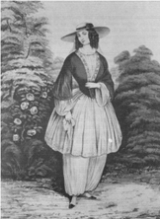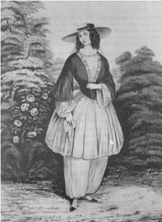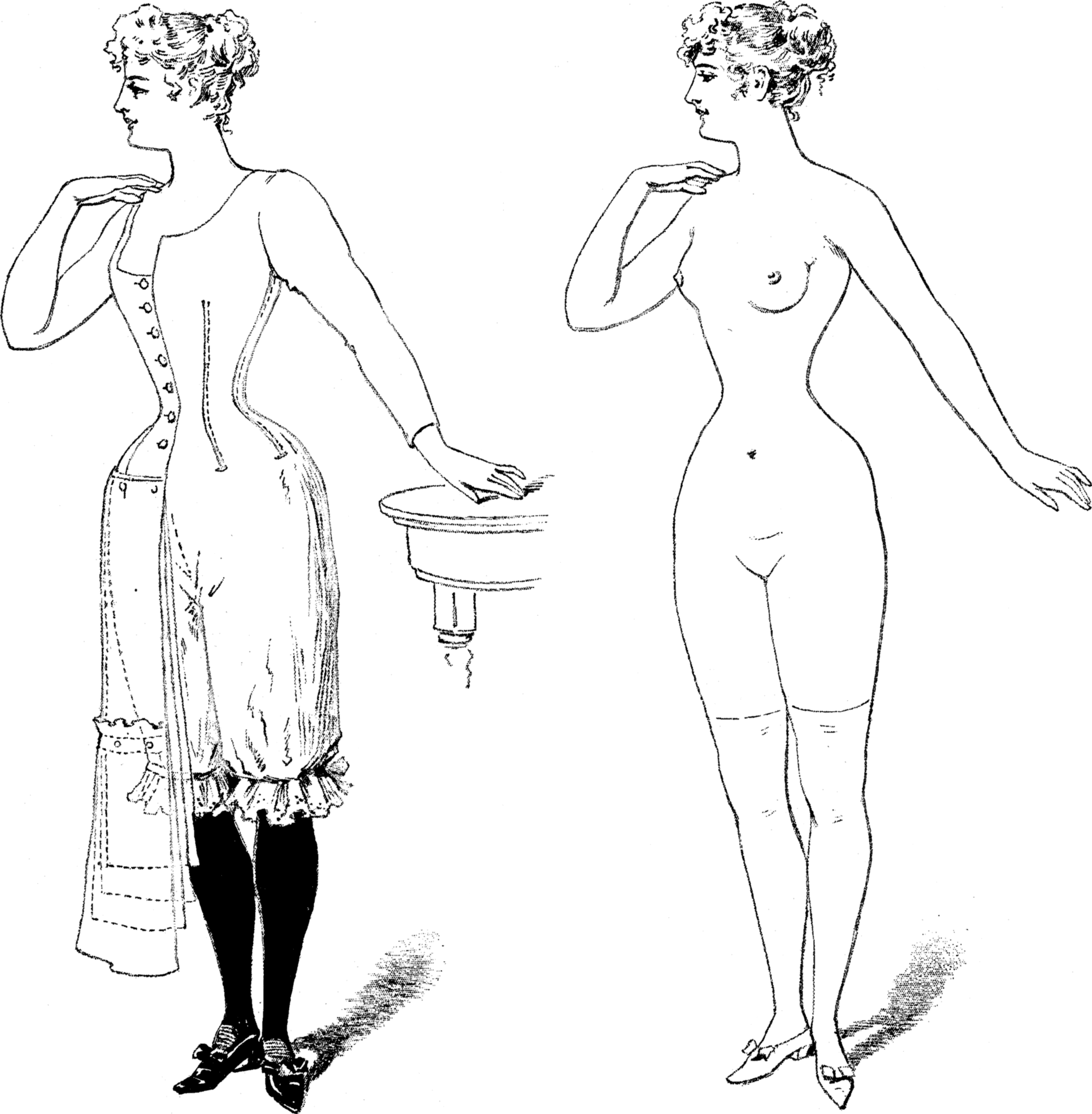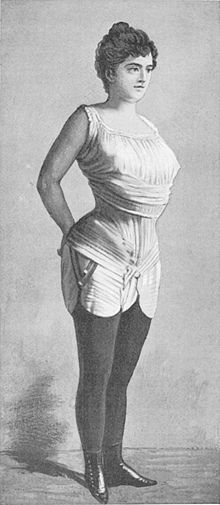
Victorian dress reform
Encyclopedia
During the middle and late Victorian period
, various reformers proposed, designed, and wore clothing supposedly more rational and comfortable than the fashions
of the time. This was known as the dress reform or rational dress movement. The movement had its greatest success in the reform of women's undergarment
s, which could be modified without exposing the wearer to social ridicule. Dress reformers were also influential in persuading women to adopt simplified garments for athletic activities such as bicycling or swimming. The dress reform movement was much less concerned with men's clothing. It did have some effects on men's undergarments, such as the widespread adoption of knitted wool union suit
s or long johns
.

The United States was home to a number of high-minded, evangelical women active in the anti-slavery and temperance movement
s. Experience in public speaking and political agitation led some of these women to demand emancipation for themselves. They wanted the vote and some of them wanted sensible clothing as well.http://www.canadiana.org/ECO/PageView/91023/0011?id=d6bdd073d6
In 1851, a New England
temperance activist named Elizabeth Smith Miller
(Libby Miller) adopted what she considered a more rational costume: loose trousers gathered at the ankles, like the trousers worn by Middle Eastern and Central Asian women, topped by a short dress or skirt and vest. She displayed her new clothing to temperance activist and suffragette
Elizabeth Cady Stanton
, who found it sensible and becoming, and adopted it immediately. In this garb she visited yet another activist, Amelia Bloomer
, the editor of the temperance magazine The Lily. Bloomer not only wore the costume, she promoted it enthusiastically in her magazine. More women wore the fashion and were promptly dubbed "Bloomers
". The Bloomers put up a valiant fight for a few years, but were subjected to ridicule in the press and harassment on the street.
Amelia Bloomer herself dropped the fashion in 1859, saying that a new invention, the crinoline
, was a sufficient reform that she could return to conventional dress. The bloomer costume died — temporarily. It was to return much later (in a different form), as a women's athletic costume in the 1890s and early 1900s.

 Reformers turned their attention to undergarments, which could be modified without attracting ridicule. Physician Alice Bunker Stockham
Reformers turned their attention to undergarments, which could be modified without attracting ridicule. Physician Alice Bunker Stockham
railed against the corset
and said of the pregnancy corset, "The Best pregnancy corset is no corset at all." The "emancipation union under flannel" was first sold in America in 1868. It combined a waist (shirt) and drawers (leggings) in the form we now know as the union suit
. While first designed for women, the union suit was also adopted by men. Indeed, it is still sold and worn today, by both men and women, as winter underclothing.
In 1878, a German professor named Gustav Jaeger published a book claiming that only clothing made of animal hair, such as wool, promoted health. A British accountant named Lewis Tomalin translated the book, then opened a shop selling Dr Jaeger’s Sanitary Woollen System, including knitted wool union suits. These were soon called "Jaegers"; they were widely popular.
Dress reformers also promoted the emancipation waist, or emancipation bodice, as a replacement for the corset
. The emancipation bodice was a tight sleeveless vest, buttoning up the front, with rows of buttons along the bottom to which could be attached petticoat
s and skirt. The entire torso would support the weight of the petticoats and skirt, not just the waist (since the undesirability of hanging the entire weight of full skirts and petticoats from a constricted waist — rather than hanging the garments from the shoulders — was another point often discussed by dress reformers).http://www.canadiana.org/ECO/PageView/91023/0008?id=d6bdd073d6 The bodices had to be fitted by a dressmaker
; patterns could be ordered through the mail.
, wore these so-called "reform" bodices. However, contemporary portrait photography
, fashion
literature
, and surviving examples of the undergarments themselves, all suggest that the corset was almost universal as daily wear by women and young ladies (and numerous fashionable men
) throughout much of the 19th and early 20th centuries.
Eventually, the reformers' critique of the corset joined a throng of voices clamoring against tightlacing
, which became gradually more common and extreme as the 19th century progressed. Preachers inveighed against tightlacing; doctors counseled patients against it; journalists wrote articles condemning the vanity and frivolity of women who would sacrifice their health for the sake of fashion. Whereas corsetting was accepted as necessary for beauty, health
, and an upright military-style posture
, tightlacing was viewed as vain and, especially at the height of Victorian Prudery
, a sign of moral indecency. However, it was in many respects simply an intensification of ordinary Victorian fashions, and the ideal image of feminine attractiveness that a Victorian woman saw around her (in fashion plates, advertisements, etc.) was invariably of a wasp-waisted, firmly-corseted lady.
Woman cyclists, such as members of the Lady Cyclists' Association
, were keen advocates of women's right to dress appropriately for the activity, as part of a belief that cycling offered women an opportunity to escape overly restrictive societal norms.
and other artistic reformers objected to the elaborately trimmed
confections of Victorian fashion with their unnatural silhouette based on a rigid corset
and hoops as both ugly and dishonest. Their wives and models adopted a revival style based on romanticised medieval influences such as puffed juliette sleeves
and trailing skirts. These were made in the soft colors of vegetable dye
s, and were ornamented with hand embroidery
in the art needlework
style.
The style spread as an "anti-fashion" called Artistic dress
in the 1860s in literary and artistic circles, died back in the 1870s
, and reemerged as Aesthetic dress in the 1880s
, where the emphasis was not so much on honesty and purity as sensuality and languor.
Victorian era
The Victorian era of British history was the period of Queen Victoria's reign from 20 June 1837 until her death on 22 January 1901. It was a long period of peace, prosperity, refined sensibilities and national self-confidence...
, various reformers proposed, designed, and wore clothing supposedly more rational and comfortable than the fashions
Victorian fashion
Victorian fashion comprises the various fashions and trends in British culture that emerged and grew in province throughout the Victorian era and the reign of Queen Victoria, a period which would last from June 1837 to January 1901. Covering nearly two thirds of the 19th century, the 63 year reign...
of the time. This was known as the dress reform or rational dress movement. The movement had its greatest success in the reform of women's undergarment
Undergarment
Undergarments or underwear are clothes worn under other clothes, often next to the skin. They keep outer garments from being soiled by bodily secretions and discharges, shape the body, and provide support for parts of it. In cold weather, long underwear is sometimes worn to provide additional...
s, which could be modified without exposing the wearer to social ridicule. Dress reformers were also influential in persuading women to adopt simplified garments for athletic activities such as bicycling or swimming. The dress reform movement was much less concerned with men's clothing. It did have some effects on men's undergarments, such as the widespread adoption of knitted wool union suit
Union suit
A union suit is a type of one-piece long underwear. Created in Utica, New York, United States, it originated as women's wear during the 19th-century United States clothing reform efforts, as an alternative to constricting garments, and soon gained popularity among men as well...
s or long johns
Long underwear
Long underwear, also called long johns, Granny pantys, or thermal underwear, is a style of two-piece underwear with long legs and long sleeves that is normally worn during cold weather. It offers an advantage over the one-piece union suit in that the wearer can choose to wear either the top,...
.
The bloomer suit

The United States was home to a number of high-minded, evangelical women active in the anti-slavery and temperance movement
Temperance movement
A temperance movement is a social movement urging reduced use of alcoholic beverages. Temperance movements may criticize excessive alcohol use, promote complete abstinence , or pressure the government to enact anti-alcohol legislation or complete prohibition of alcohol.-Temperance movement by...
s. Experience in public speaking and political agitation led some of these women to demand emancipation for themselves. They wanted the vote and some of them wanted sensible clothing as well.http://www.canadiana.org/ECO/PageView/91023/0011?id=d6bdd073d6
In 1851, a New England
New England
New England is a region in the northeastern corner of the United States consisting of the six states of Maine, New Hampshire, Vermont, Massachusetts, Rhode Island, and Connecticut...
temperance activist named Elizabeth Smith Miller
Elizabeth Smith Miller
Elizabeth Smith Miller , known as 'Libby' was an advocate and financial supporter of the women’s rights movement and the daughter of antislavery philanthropist Gerrit Smith and spouse, the abolitionist Ann Carroll Fitzhugh. Elizabeth Miller was born September 20, 1822. In 1843, Elizabeth married...
(Libby Miller) adopted what she considered a more rational costume: loose trousers gathered at the ankles, like the trousers worn by Middle Eastern and Central Asian women, topped by a short dress or skirt and vest. She displayed her new clothing to temperance activist and suffragette
Suffragette
"Suffragette" is a term coined by the Daily Mail newspaper as a derogatory label for members of the late 19th and early 20th century movement for women's suffrage in the United Kingdom, in particular members of the Women's Social and Political Union...
Elizabeth Cady Stanton
Elizabeth Cady Stanton
Elizabeth Cady Stanton was an American social activist, abolitionist, and leading figure of the early woman's movement...
, who found it sensible and becoming, and adopted it immediately. In this garb she visited yet another activist, Amelia Bloomer
Amelia Bloomer
Amelia Jenks Bloomer was an American women's rights and temperance advocate. Even though she did not create the women's clothing reform style known as bloomers, her name became associated with it because of her early and strong advocacy.-Early life:Bloomer came from a family of modest means and...
, the editor of the temperance magazine The Lily. Bloomer not only wore the costume, she promoted it enthusiastically in her magazine. More women wore the fashion and were promptly dubbed "Bloomers
Bloomers (clothing)
Bloomers is a word which has been applied to several types of divided women's garments for the lower body at various times.-Fashion bloomers :...
". The Bloomers put up a valiant fight for a few years, but were subjected to ridicule in the press and harassment on the street.
Amelia Bloomer herself dropped the fashion in 1859, saying that a new invention, the crinoline
Crinoline
Crinoline was originally a stiff fabric with a weft of horse-hair and a warp of cotton or linen thread. The fabric first appeared around 1830, but by 1850 the word had come to mean a stiffened petticoat or rigid skirt-shaped structure of steel designed to support the skirts of a woman’s dress into...
, was a sufficient reform that she could return to conventional dress. The bloomer costume died — temporarily. It was to return much later (in a different form), as a women's athletic costume in the 1890s and early 1900s.
Undergarment reform


Alice Bunker Stockham
thumb|right|Dr Alice Bunker StockhamAlice Bunker Stockham was an obstetrician and gynecologist from Chicago, and the fifth woman to be made a doctor in the United States...
railed against the corset
Corset
A corset is a garment worn to hold and shape the torso into a desired shape for aesthetic or medical purposes...
and said of the pregnancy corset, "The Best pregnancy corset is no corset at all." The "emancipation union under flannel" was first sold in America in 1868. It combined a waist (shirt) and drawers (leggings) in the form we now know as the union suit
Union suit
A union suit is a type of one-piece long underwear. Created in Utica, New York, United States, it originated as women's wear during the 19th-century United States clothing reform efforts, as an alternative to constricting garments, and soon gained popularity among men as well...
. While first designed for women, the union suit was also adopted by men. Indeed, it is still sold and worn today, by both men and women, as winter underclothing.
In 1878, a German professor named Gustav Jaeger published a book claiming that only clothing made of animal hair, such as wool, promoted health. A British accountant named Lewis Tomalin translated the book, then opened a shop selling Dr Jaeger’s Sanitary Woollen System, including knitted wool union suits. These were soon called "Jaegers"; they were widely popular.
Dress reformers also promoted the emancipation waist, or emancipation bodice, as a replacement for the corset
Corset
A corset is a garment worn to hold and shape the torso into a desired shape for aesthetic or medical purposes...
. The emancipation bodice was a tight sleeveless vest, buttoning up the front, with rows of buttons along the bottom to which could be attached petticoat
Petticoat
A petticoat or underskirt is an article of clothing for women; specifically an undergarment to be worn under a skirt or a dress. The petticoat is a separate garment hanging from the waist ....
s and skirt. The entire torso would support the weight of the petticoats and skirt, not just the waist (since the undesirability of hanging the entire weight of full skirts and petticoats from a constricted waist — rather than hanging the garments from the shoulders — was another point often discussed by dress reformers).http://www.canadiana.org/ECO/PageView/91023/0008?id=d6bdd073d6 The bodices had to be fitted by a dressmaker
Dressmaker
A dressmaker is a person who makes custom clothing for women, such as dresses, blouses, and evening gowns. Also called a mantua-maker or a modiste.-Notable dressmakers:*Cristobal Balenciaga*Charles Frederick Worth...
; patterns could be ordered through the mail.
Criticisms of tightlacing
It is not clear how many women, in either the Americas or on the ContinentEurope
Europe is, by convention, one of the world's seven continents. Comprising the westernmost peninsula of Eurasia, Europe is generally 'divided' from Asia to its east by the watershed divides of the Ural and Caucasus Mountains, the Ural River, the Caspian and Black Seas, and the waterways connecting...
, wore these so-called "reform" bodices. However, contemporary portrait photography
Portrait photography
Portrait photography or portraiture is the capture by means of photography of the likeness of a person or a small group of people , in which the face and expression is predominant. The objective is to display the likeness, personality, and even the mood of the subject...
, fashion
Fashion
Fashion, a general term for a currently popular style or practice, especially in clothing, foot wear, or accessories. Fashion references to anything that is the current trend in look and dress up of a person...
literature
Magazine
Magazines, periodicals, glossies or serials are publications, generally published on a regular schedule, containing a variety of articles. They are generally financed by advertising, by a purchase price, by pre-paid magazine subscriptions, or all three...
, and surviving examples of the undergarments themselves, all suggest that the corset was almost universal as daily wear by women and young ladies (and numerous fashionable men
Dandy
A dandy is a man who places particular importance upon physical appearance, refined language, and leisurely hobbies, pursued with the appearance of nonchalance in a cult of Self...
) throughout much of the 19th and early 20th centuries.
Eventually, the reformers' critique of the corset joined a throng of voices clamoring against tightlacing
Tightlacing
Tightlacing is the practice of wearing a tightly-laced corset to achieve extreme modifications to the figure and posture and experience the sensations of a very tight corset. Those who practice tightlacing are called tightlacers...
, which became gradually more common and extreme as the 19th century progressed. Preachers inveighed against tightlacing; doctors counseled patients against it; journalists wrote articles condemning the vanity and frivolity of women who would sacrifice their health for the sake of fashion. Whereas corsetting was accepted as necessary for beauty, health
Health
Health is the level of functional or metabolic efficiency of a living being. In humans, it is the general condition of a person's mind, body and spirit, usually meaning to be free from illness, injury or pain...
, and an upright military-style posture
Human position
Human positions refers to the different positions that the human body can take.There are several synonyms that refer to the human position, often used interchangeably, but having specific flavors....
, tightlacing was viewed as vain and, especially at the height of Victorian Prudery
Victorian morality
Victorian morality is a distillation of the moral views of people living at the time of Queen Victoria's reign and of the moral climate of the United Kingdom throughout the 19th century in general, which contrasted greatly with the morality of the previous Georgian period...
, a sign of moral indecency. However, it was in many respects simply an intensification of ordinary Victorian fashions, and the ideal image of feminine attractiveness that a Victorian woman saw around her (in fashion plates, advertisements, etc.) was invariably of a wasp-waisted, firmly-corseted lady.
Rational Dress Society
The Rational Dress Society was an organisation founded in 1881 in London. It described its purpose thus:- The Rational Dress Society protests against the introduction of any fashion in dress that either deforms the figure, impedes the movements of the body, or in any way tends to injure the health. It protests against the wearing of tightly-fitting corsets; of high-heeled shoes; of heavily-weighted skirts, as rendering healthy exercise almost impossible; and of all tie down cloaks or other garments impeding on the movements of the arms. It protests against crinolines or crinolettes of any kind as ugly and deforming….[It] requires all to be dressed healthily, comfortably, and beautifully, to seek what conduces to birth, comfort and beauty in our dress as a duty to ourselves and each other. http://www.glily.com/preraphs.htm
Woman cyclists, such as members of the Lady Cyclists' Association
Lady Cyclists' Association
The Lady Cyclists' Association was the United Kingdom's - and probably the world's - first cycling organisation expressly for women, set up to provide rides, tours and social gatherings for women cyclists.-History:...
, were keen advocates of women's right to dress appropriately for the activity, as part of a belief that cycling offered women an opportunity to escape overly restrictive societal norms.
Artistic dress movement
The Pre-Raphaelite BrotherhoodPre-Raphaelite Brotherhood
The Pre-Raphaelite Brotherhood was a group of English painters, poets, and critics, founded in 1848 by William Holman Hunt, John Everett Millais and Dante Gabriel Rossetti...
and other artistic reformers objected to the elaborately trimmed
Trim (sewing)
Trim or trimming in clothing and home decorating is applied ornament, such as gimp, passementerie, ribbon, ruffles, or, as a verb, to apply such ornament....
confections of Victorian fashion with their unnatural silhouette based on a rigid corset
Corset
A corset is a garment worn to hold and shape the torso into a desired shape for aesthetic or medical purposes...
and hoops as both ugly and dishonest. Their wives and models adopted a revival style based on romanticised medieval influences such as puffed juliette sleeves
Sleeve
Sleeve is that part of a garment which covers the arm, or through which the arm passes or slips. The pattern of the sleeve is one of the characteristics of fashion in dress, varying in every country and period...
and trailing skirts. These were made in the soft colors of vegetable dye
Dye
A dye is a colored substance that has an affinity to the substrate to which it is being applied. The dye is generally applied in an aqueous solution, and requires a mordant to improve the fastness of the dye on the fiber....
s, and were ornamented with hand embroidery
Embroidery
Embroidery is the art or handicraft of decorating fabric or other materials with needle and thread or yarn. Embroidery may also incorporate other materials such as metal strips, pearls, beads, quills, and sequins....
in the art needlework
Art needlework
Art needlework was a type of surface embroidery popular in the later nineteenth century under the influence of the Pre-Raphaelites and the Arts and Crafts Movement....
style.
The style spread as an "anti-fashion" called Artistic dress
Artistic Dress movement
The Artistic Dress movement and its successor, Aesthetic Dress, were fashion trends in nineteenth century clothing that rejected the highly structured and heavily trimmed Paris fashion of the day in favour of beautiful materials and simplicity of design....
in the 1860s in literary and artistic circles, died back in the 1870s
1870s in fashion
1870s fashion in European and European-influenced clothing is characterized by a gradual return to a narrow silhouette after the full-skirted fashions of the 1850s and 1860s.-Overview:...
, and reemerged as Aesthetic dress in the 1880s
1880s in fashion
Fashion in the 1880s in European and European-influenced countries is characterized by the return of the bustle. The long, lean line of the 1870s was replaced by a full, curvy silhouette with gradually widening shoulders. Fashionable waists were low and tiny below a full, low bust supported by a...
, where the emphasis was not so much on honesty and purity as sensuality and languor.
Girl athletes and working women
In the 19th century, poor women were known to wear corsets "boned" with rope, rather than steel or bone, to facilitate work in the field.See also
- Victorian fashionVictorian fashionVictorian fashion comprises the various fashions and trends in British culture that emerged and grew in province throughout the Victorian era and the reign of Queen Victoria, a period which would last from June 1837 to January 1901. Covering nearly two thirds of the 19th century, the 63 year reign...
- Corset controversyCorset controversyThe corset controversy is an ensemble of letters and articles concerning the corset that appeared in newspapers and periodicals in the 19th century.-Introduction:...
- Bicycle
- History of the bicycle
- Liberty bodiceLiberty bodiceThe liberty bodice , like the emancipation bodice or North American emancipation waist, was an undergarment for women and girls invented towards the end of the 19th century, as an innovative alternative to a corset. In the United Kingdom they were well-known for decades, with some older women...

